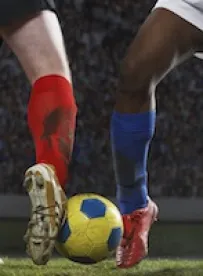Following the unlikely victory of little-known Sport Pacifico over relative giants Estudiantes in an Argentinian cup match this month, came the still more unlikely admission by Sport Pacifico defender Federico Allende that during the game he used a needle to pierce opponents, a tactic he openly bragged about in a radio interview.
The jury is out on how to punish Allende, although the club’s president has hinted at expulsion. Had this incident not taken place in the course of a sports match, or possibly regardless of the fact that it did, many would have expected (or now do expect) the law to intervene.
The incident begs the enduring question of what function should be served by the law in the adjudication of violence perpetrated during sports matches. Or are sports-related offences best left to sports’ various governing bodies to handle? In this two-part article, Sports Shorts looks in Part One at how the law has historically treated violence in sport, and in Part Two considers a few of the arguments typically made against invoking the law in this context.
Are sports special?
To a greater or lesser extent, many contact sports such as football, rugby and boxing involve physical contact that in any other situation would amount to assault (under the Offences Against the Persons Act 1861). Sport provides an exception for the reason that participants impliedly consent to such physicality. The same rationale applies in other contexts including surgery, tattooing and piercing (although, needless to say, not of the kind favoured by Allende). But the doctrine of implied consent is not without its limits, and therein lies the crux of the issue: in what circumstances does physical contact exceed the bounds of such consent. Players of contact sports no doubt accept the certainty of being tackled, and the possibility of being fouled – but surely only insofar as this is incidental to the game, not when it is a deliberate act of harm.
Examples of “off-the-ball” incidents
History abounds with incidents of sporting violence that took place “off-the-ball”, that is to say, not in the course of an action directly pursuant to the sport’s objective, which led to a prison sentence for the perpetrator. In 1995, Duncan Ferguson was handed a three month sentence for head-butting Josh McStay in a match between Raith Rovers and Rangers. More recently, in 2006, a first round FA Cup match saw Barrow defender James Cotterill punch Bristol Rovers striker Sean Rigg, for which he was given four months in prison for grievous bodily harm (‘GBH’). Further afield, a boxing match hosted in New York between James Butler and Richard Grant in 2001 ended with Butler sucker-punching Grant after the judges found unanimously against him. In footage of the fight, the commentator can be heard exclaiming “that is assault! That is assault! He should be arrested on the spot”. And so he was – police escorted him away and he was eventually incarcerated for four months.
Off-the-ball incidents such as these are generally much less contentious than those occurring on-the-ball. In a leading case, it was acknowledged that in taking part a player assumes the risk of injury, “but he does not agree that this more serious kind of injury may be inflicted deliberately”. It was also acknowledged how difficult it is to establish where the critical level lies at which implied consent ceases. The cases mentioned thus far can be considered to comfortably exceed this critical level, hence the convictions.
Yet there are also many off-the-ball cases when the law did not intervene, although conceivably it could have done if the above examples are anything to go by. Lance Hohaia was on the receiving end of two punches – one as he lay unconscious – by Wigan prop Ben Flower in rugby league’s 2013 Super League Grand Final, retiring shortly thereafter citing recurring concussion. Several other rugby players are no strangers to violent conduct; Manu Tuilagi landed a flurry of punches on Chris Ashton in a premiership game, while Ashton himself was banned for ten and thirteen weeks respectively for eye gouging and biting opponents.
Examples of “on-the-ball” incidents
More contentious are those incidents that happen on-the-ball, in relation to which the doctrine of implied consent at once seems more applicable.
Seldom have “on-the-ball” acts of aggression culminated in convictions for assault. Only two such cases exist on record in this country. One occurred during a Sunday league match in 2010 in which Mark Chapman was tackled by Terry Johnson; Chapman was shielding the ball out of play when Johnson player tackled him from behind, breaking his leg in two places – he needed reconstructive surgery including a skin graft. Johnson received a six month sentence for GBH. The other case was during an amateur rugby match in 1995 when one player elbowed another in the head, breaking his cheek bone. The offender was given a six month sentence, reduced on appeal by two months to reflect the fact the incident occurred when the ball was being played.
No doubt some readers will recall the leg-breaking tackle made on Arsenal’s Eduardo da Silva in in 2008. Then FIFA president Sepp Blatter expressed his view that “players who do this kind of thing intentionally should be banned from the game,” and furthermore that “attacking somebody is criminal, whether it happens on a football pitch or elsewhere. It is a crime and should be treated as such.”
Alexander De Wild authored this post.



 />i
/>i

